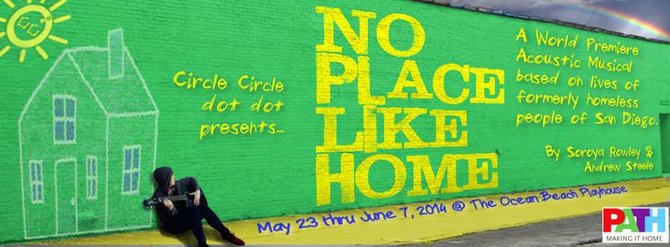 Facebook
Facebook
 X
X
 Instagram
Instagram
 TikTok
TikTok
 Youtube
Youtube

There should be a law in theater: don’t cubbyhole. Don’t typecast actors; don’t hogtie a company with a reductive label.
Call it the Tennessee Williams Statute. Once he became a success, critics and audiences demanded More of Same. Drove him to drink — well, even more. Add an Edward Albee Codocil: encourage artistic growth (every time he tried, people balked, wanting more Who’s Afraids).
Circle Circle dot dot builds plays around local topics, often providing insights into parts of San Diego marginalized or rarely seen (as in their Deconstruction of a Drag Queen).
With No Place Like Home, the intrepid company made a leap. Written and directed by Soroya Rowley and Andrew Steele, it’s their first musical. Though results are mixed, energy and talent make the 90-minute piece worth seeing.
She’s such a “caution” to her uptight stepmother, when young Daisy wants to live at home to save money for school, they clash over her Satanic tank-top. Next thing she knows, Daisy’s out on the street, and in no way prepared for a hardscrabble, possibly life-threatening existence, with winter coming on.
The opening sequence, including Rowley’s song “Broken,” is the show’s best part. Daisy wanders, lost. She learns about homeless shelters in San Diego — how new people must wait in line, often for days and weeks; how the women’s are usually full (one reason: homeless from the north “winter” in San Diego for the milder climate). She’s almost assaulted. She makes friends and learns to take turns sleeping, since someone in a “pack” must be awake at all times.
Daisy hears about R.O.A.D., a safety valve that sounds a lot like P.A.T.H.: “People Assisting the Homeless” — which has been a beacon of hope for disabled homeless in Southern California. Once Daisy hears about R.O.A.D, the end is never in doubt. For her, at least, if no one else.
The book needs sharper dialogue (and should cut out the lines that repeat what happened in the previous scene). It also has a sag in the middle, when Daisy leaves the area. It loses detail and becomes predictable from then on.
What is not: the skill with which Circle Circle tackles its first musical. Three acoustic guitars, “found” percussion — bang on boards, etc. — and an accordion (played with brio by Stacey Hardke) create a lively soundscape throughout.
It should come as no surprise that multi-talented Katie Harroff can also sing up a storm. She plays Daisy and belts out “Broken” with Taylor Wycoff (a maybe-too-saintly Mary) and “On the Road” with the energetic, fully committed Jon Huckaby (the mercurial Chris).
Patrick Kelly, Andrew Steele, and Michael Nieto back up numbers with quality guitar work. Kelly shines with “Telemarketing” and “He Strums a Song.”
The “set,” if you’ve never been to the Ocean Beach Playhouse, is a pip. Once an alley bar, then a recording studio, the “theater” is a wall-to-wall, multi-purpose homage to art. The raised stage makes for an engaging intimacy.


There should be a law in theater: don’t cubbyhole. Don’t typecast actors; don’t hogtie a company with a reductive label.
Call it the Tennessee Williams Statute. Once he became a success, critics and audiences demanded More of Same. Drove him to drink — well, even more. Add an Edward Albee Codocil: encourage artistic growth (every time he tried, people balked, wanting more Who’s Afraids).
Circle Circle dot dot builds plays around local topics, often providing insights into parts of San Diego marginalized or rarely seen (as in their Deconstruction of a Drag Queen).
With No Place Like Home, the intrepid company made a leap. Written and directed by Soroya Rowley and Andrew Steele, it’s their first musical. Though results are mixed, energy and talent make the 90-minute piece worth seeing.
She’s such a “caution” to her uptight stepmother, when young Daisy wants to live at home to save money for school, they clash over her Satanic tank-top. Next thing she knows, Daisy’s out on the street, and in no way prepared for a hardscrabble, possibly life-threatening existence, with winter coming on.
The opening sequence, including Rowley’s song “Broken,” is the show’s best part. Daisy wanders, lost. She learns about homeless shelters in San Diego — how new people must wait in line, often for days and weeks; how the women’s are usually full (one reason: homeless from the north “winter” in San Diego for the milder climate). She’s almost assaulted. She makes friends and learns to take turns sleeping, since someone in a “pack” must be awake at all times.
Daisy hears about R.O.A.D., a safety valve that sounds a lot like P.A.T.H.: “People Assisting the Homeless” — which has been a beacon of hope for disabled homeless in Southern California. Once Daisy hears about R.O.A.D, the end is never in doubt. For her, at least, if no one else.
The book needs sharper dialogue (and should cut out the lines that repeat what happened in the previous scene). It also has a sag in the middle, when Daisy leaves the area. It loses detail and becomes predictable from then on.
What is not: the skill with which Circle Circle tackles its first musical. Three acoustic guitars, “found” percussion — bang on boards, etc. — and an accordion (played with brio by Stacey Hardke) create a lively soundscape throughout.
It should come as no surprise that multi-talented Katie Harroff can also sing up a storm. She plays Daisy and belts out “Broken” with Taylor Wycoff (a maybe-too-saintly Mary) and “On the Road” with the energetic, fully committed Jon Huckaby (the mercurial Chris).
Patrick Kelly, Andrew Steele, and Michael Nieto back up numbers with quality guitar work. Kelly shines with “Telemarketing” and “He Strums a Song.”
The “set,” if you’ve never been to the Ocean Beach Playhouse, is a pip. Once an alley bar, then a recording studio, the “theater” is a wall-to-wall, multi-purpose homage to art. The raised stage makes for an engaging intimacy.
Comments